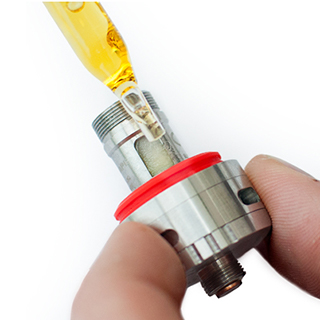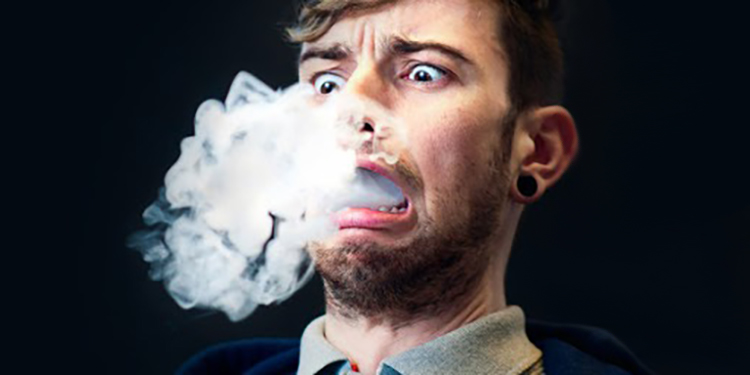Here’s a quick review of this new e-juice I tried. It’s called “Mèche Brûlée.”
On the nose, you’re struck with the delicate flavour of a smouldering stack of old newspapers, and it’s accompanied by the inimitable sensation of somebody sandpapering the inside of your nostrils until the heat from the friction almost starts to burn.
The feeling going down is akin to somebody raking the back of your throat with a hot cheese grater, and the taste filling your mouth conjures up images of those choking, noxious knockout gases you always see in the 60s Batman series. You know, the ones that are faintly purple and cause the dynamic duo to clutch their throats and fall to the ground, gasping for air.
Wait a minute, “Mèche Brûlée” isn’t an e-juice at all; it’s just a clumsy, Google-led translation of “burnt wick” into French. And yes, that’s exactly the taste you get from a burnt coil, or more specifically, a burnt wick. As if the horrendous taste wasn’t enough, it also ruins the whole coil head and costs you money.
The good news is that by taking a few simple steps, you can stop your coils from burning out, or at least make it a lot less likely.
How do you know if your coil is burnt?
If your coil is truly burnt out, you will know about it – the taste of Meche Brûlée is truly unmistakable!
If your coil is only slightly burnt, you may get a slight burnt taste, as if something’s not quite right. Given that we know that burnt coils can produce harmful chemicals, you should probably still change it.
Occasionally, you’ll also get a burnt taste when you have just replaced a burnt out coil. Sometimes this will disappear after a few puffs, but at other times you may need to replace the e-liquid.
Why does your coil taste burnt?
If you want to avoid burnt coils, the most important thing to understand is why coils get burnt in the first place. This is really simple and it underpins all the advice given in this post.
First, think about when you’re vaping but not getting a burnt taste. When you hit the fire button, electricity flows through your coil and it gets hot. The heat given off by the coil is taken up by the e-juice, which is soaked into the wick, and it turns the juice into vapour. Because you have the juice there to take up some of the heat energy given off by the coil, the temperature of the coil doesn’t get too high.
When the juice in the wick has been vaporised, the wick dries out a little. However, you have a tank full of e-juice surrounding the coil, and this is constantly replacing the juice in the wick. This means that by the time you go to take another puff, the wick is soaked again and everything works as it should.
But what happens when there’s no juice in the wick, or just not enough? Now, when you hit the fire button and the coil heats up, there isn’t much there to take up that additional heat. As a result, the temperature of the coil increases. This leads to two (equally unwanted) things happening:
- The juice remaining in the wick gets “overcooked,” heating up to an excessive degree and causing the PG to breaking down into formaldehyde. In case this needs clarifying: formaldehyde tastes absolutely gross.
- Without anything to protect it from heat, the wick is directly exposed to the glowing-hot coil. Since it’s probably made of cotton, the wick burns. If the wick was completely dry, it would literally erupt in flames. And yes, burning cotton tastes horrible too.
These two things are the key ingredients in the “Mèche Brûlée” e-juice described in the introduction. Burning cotton with notes of formaldehyde. Disgusting with some extra-disgusting thrown in for good measure.
So How Can We Stop Our Coils From Burning Out?
Well, from the above, it’s clear that the key thing we need to ensure is that there’s always juice in the wick when we vape.
This means you shouldn’t “dry burn” your coils, because most wicks are made from cotton and will simply get ruined without juice there to protect them. For ceramic wicks, dry burning is fine, and you can get away with short bursts for silica, but not for cotton.
There’s less of a risk when you have juice in your wick, but you still have to take some steps to protect your coil. When you hit the fire button, you deplete the juice in the wick, and we need to make sure our devices are set up so that the flow of new e-liquid can keep up with the rate we’re vaporizing it.
That’s the key point for how to stop your coil from burning. But what does this mean from a vaper’s perspective? What do we actually need to do?
9 Ways to Stop Burnt Coils
The best ways to stop your coil from burning are:
- Prime your coils
- Stop chain vaping
- Reduce power settings
- Keep your vape tank topped up
- Use an e-liquid with more PG
- Try an e-liquid with less sweetener
- Use temperature control
- Use smart mode
- Use auto-priming technology
Let’s all explore all these in more detail!
1 – Prime Your Coils Before Vaping
If you don’t “prime” your coils before you start vaping, you can burn your coil before you’ve even gotten any use of out of it.
When you first install a new coil, the wick has to go from being completely dry to completely soaked. This takes time, so you usually have to wait five minutes or so between filling up your tank and taking your first puff. If you wait long enough, priming isn’t strictly necessary, but the problem is that it’s really hard to tell whether your wick is completely soaked. And if it isn’t, when you press fire, there isn’t enough juice there to absorb the heat, and this causes the problems described above.
Priming your coil is just manually soaking the wicks before you install it. Coil heads tend to have an opening in the top and some ports around the side where the wick is visible. To prime the coil, add a few drops of e-juice to the opening in the top (around 3 to 5 is enough) and then soak the exposed wick at the ports around the side. This doesn’t take much for each port, but just ensure the parts you can see are saturated with e-juice.

